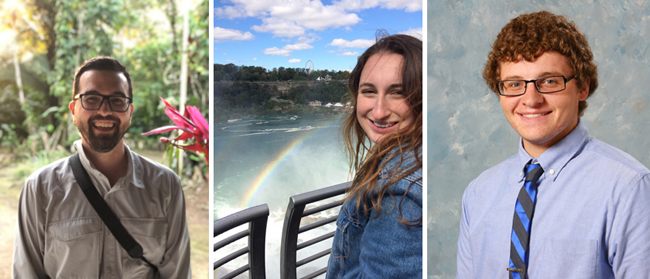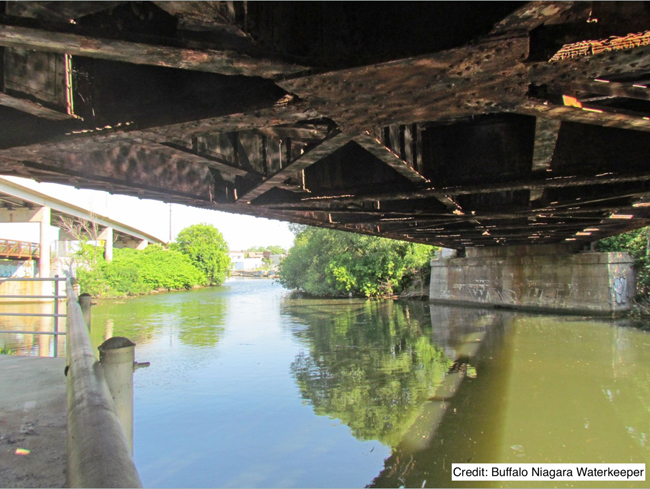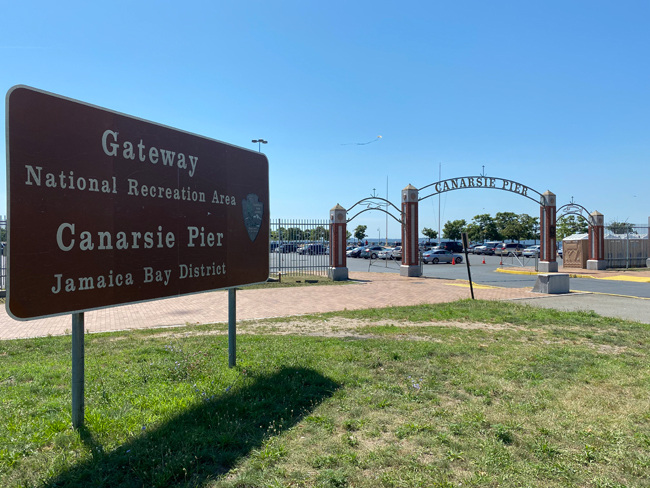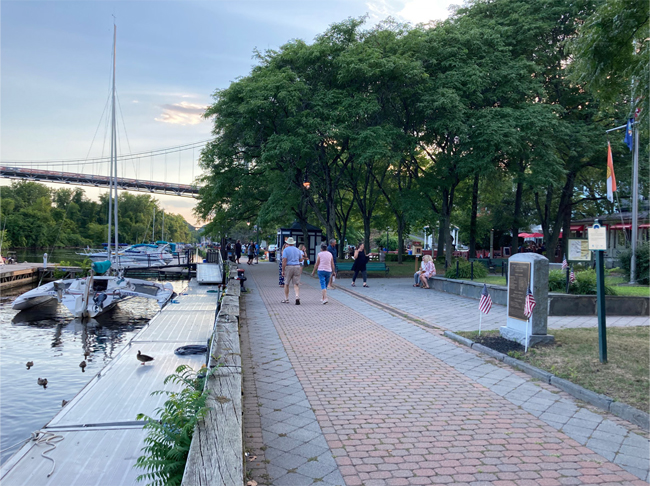
2020 NYSG Coastal Resilience Law and Policy Fellows: (l-r) CUNY School of Law student Connor Lie-Spahn; Elisabeth Haub School of Law student Emma Alvarez Campbell; University at Buffalo School of Law student Nicholas Pistory
New York Sea Grant, three law schools announce Environmental Law and Planning Resource Guides for Buffalo, Canarsie, and Hudson River communities
Contacts:
• Rebecca L. Shuford, Ph.D., New York Sea Grant Director, E: rebecca.shuford@stonybrook.edu, P: 631-632-6905
• Katherine Bunting-Howarth, Ph.D., J.D., New York Sea Grant Associate Director, E: kathybh@cornell.edu, P: 607-255-2832
• Kara Lynn Dunn, NYSG's Freelance Great Lakes Publicist, E: karalynn@gisco.net, P: (315) 465-7578
(For contacts at partner universities, please contact Kara)
Ithaca, NY, May 10, 2021 - New York Sea Grant, in partnership with the University at Buffalo School of Law, the City University of New York School of Law, and the Elisabeth Haub School of Law at Pace University, has announced environmental law and policy resource guides for the communities of Buffalo, Canarsie, and the Hudson River region.
The new resource guides help municipalities, property owners, and conservation groups better address comprehensive planning, local property rights and regulations, local resilience needs, and redevelopment opportunities related to environmental concerns and climate change.
New York Sea Grant received two legal capacity-building grants from the National Sea Grant Law Center to assess the needs that a New York Coastal Resilience Law and Policy Fellowship Program might address, and to create the program in 2020. The first action of the new partnership was to establish a summer fellowship program. As a part of this inaugural fellowship, three law degree students, one from each collaborating university, developed a white paper and two ArcGIS story map resources as follow:
• BUFFALO — The Lowerscajaquada Creek: Empowering Communities Through Historical and Legal Analysis (Story Map), Nicholas Pistory, a third-year University at Buffalo School of Law student with an environmental law concentration, from Edinboro, Pennsylvania;
• CANARSIE — Canarsie Resilient: Mapping Resilience on Brooklyn’s Jamaica Bay (Story Map), Connor Atlas Lie-Spahn, a Juris Doctorate degree student City University of New York School of Law; from Inwood, a neighborhood in the New York City borough of Manhattan; and
• HUDSON RIVER COMMUNITIES — Planning for Climate Change Where You Live: A Guide for Local Governments and Community Members on the Hudson River (PDF), Emma Alvarez Campbell, Elisabeth Haub School of Law at Pace University, a third-year law student from Cresskill, New Jersey.
For more information on each resource guide, each student, and the New York Sea Grant Law and Policy Fellowships program, contact New York Sea Grant Associate Director Katherine Bunting-Howarth at kathybh@cornell.edu.
More Info: On Location with the Summer 2020 Law Fellows

The Lowerscajaquada (pronounced ska-jack-quah-duh) Creek, Credit: Buffalo Niagara Waterkeeper
BUFFALO — The Lowerscajaquada Creek: Empowering Communities Through Historical and Legal Analysis
Thescajaquada Creek watershed covers 29 square miles and includes the Town of Lancaster, Village of Depew, Town of Cheektowaga, and City of Buffalo. This resource, developed by University at Buffalo (UB) law student Nicholas Pistory, highlights steps that local communities can take to interact with the Great Lakes Water Quality Agreement, Buffalo Local Waterfront Revitalization Plan, and Buffalo Green Code, all of which impact thescajaquada Creek area.
“Thisscajaquada story map expands upon earlier environmentally, historically, and culturally-focused work by such groups as Buffalo Niagara Waterkeeper and the University at Buffalo School of Architecture’sscajaquada Creek Uncovered preservation studio project. A legal analysis of several laws relevant to the creek area and key contacts have been added,” said Pistory.
Pistory is a third-year UB School of Law student with an environmental law concentration. He is from Edinboro, Pennsylvania.

Canarsie Pier. Credit: Connor Lie-Spahn
CANARSIE — Canarsie Resilient: Mapping Resilience on Jamaica Bay
Conversations with local residents sparked this story mapping project developed by CUNY School of Law student Connor Lie-Spahn. Conversation focused on the potential of 18 publicly-owned spaces, such as the Canarsie Pier, parkland and recreational fields, and city-owned vacant lots, to support resiliency building, and the challenge of the complex network of city, state, and federal agencies, statutes, and regulations related to public spaces. The project provides an inventory of local publicly-owned outdoor spaces, and highlights the agencies and laws most relevant to their use, including serving as cooling spaces during periods of extreme heat, and as community garden spaces.
“A common theme was a desire for information elucidating which government agencies control the myriad public spaces in and around Canarsie. A conversation with an environmentalist activist and community board member Maria Garrett from Canarsie inspired the story map format. She had encountered the labyrinthine web of city, state, and federal agencies when trying to organize clean-ups of the Fresh Creek Nature Preserve during a time when people were illegally dumping there and causing fire hazards. My hope is that Canarsie community members interested in optimizing public spaces will use this new resource as a roadmap for whom to involve or contact,” says Lie-Spahn.
Lie-Spahn is a Juris Doctorate degree student at the City University of New York School of Law. He is from Inwood, a neighborhood in the New York City borough of Manhattan.

A view of Kingston, NY's waterfront. Credit: Jessica Kuonen/NYSG
HUDSON RIVER COMMUNITIES — Planning for Climate Change Where You Live: A Guide for Local Governments and Community Members on the Hudson River
This white paper by Pace University Elisabeth Haub School of Law student Emma Alvarez Campbell considers the legal authority and limitations of municipalities related to issues such as sea level rise, increased precipitation, and hurricane impact, and how they relate to comprehensive planning, community risk and vulnerability, zoning, and public engagement. Success stories highlighted in this white paper include the Beacon Waterfront Park Rezoning in 2017, adoption of the “Kingston 2025” Comprehensive Plan in 2016, installation of the Kingston Library Rain Garden, and community meetings held by the Piermont Waterfront Resiliency Commission.
Campbell interviewed stakeholders in towns along the Hudson River. The conversations identified climate change as a common concern. She notes, “The opportunity to problem-solve for local communities along the Hudson River is close to home for me. My hometown of Cresskill, New Jersey, shares a shoreline with the Hudson, and at Pace (University) there is a focus on the Hudson River’s environmental integrity with programs like the Environmental Litigation Clinic are working to protect it. This resource will facilitate communities’ planning for protection from the impacts of climate change.”
Emma Alvarez Campbell, from Cresskill, New Jersey, is a third-year law student at the Elisabeth Haub School of Law at Pace University.
More Info: In Their Words
“Coastal communities are exposed to a host of unique natural, ecological, and man-made concerns that impact their shorelines, economies, and residents. Our first New York Sea Grant Law and Policy Fellowship students researched, developed, and packaged resources to help local leaders and citizens utilize local, state, and federal laws and policies to protect and revitalize critical waterfront areas.” — Katherine Bunting-Howarth, Ph.D., J.D., New York Sea Grant Associate Director; Assistant Director of Cornell Cooperative Extension, Ithaca, NY
“Communities throughout New York State, particularly our marine and fresh water coastal communities, are experiencing a variety of climate change-related influences on lives and properties. New York Sea Grant is pleased to work in collaboration with the law schools at the University at Buffalo, Pace University, and the City University of New York to provide locally relevant tools and resources, such as those developed by the Law and Policy Fellows, to support planning and decision-making processes.” — Rebecca L. Shuford, Ph.D., New York Sea Grant Director
“This type of project provides excellent win-win-win service learning. Our students get a chance to learn from experts and produce work that will make a difference. Sea Grant receives work products that can be shared within their network and beyond. Community members have access to information that can help individuals, non-profits, communities, and others become better stewards of New York’s shoreline ecosystems.” — Kim Diana Connolly, University at Buffalo School of Law Environmental Law Clinic Director and Professor
“Haub Law is pleased to have worked with New York Sea Grant and others to provide a student like Emma Campbell the opportunity to develop useful tools for local governments to combat the effects of climate change on the Hudson River.” — Jessica Bacher, Executive Director of the Land Use Law Center at the Elisabeth Haub School of Law at Pace University
“By building a collaborative network between academics, communities, and Sea Grant, this project built environmental justice capacities across New York State. One long-term result will be better centering of community needs and aspirations in ongoing discussions about protecting and-or developing waterfronts. CUNY Law was glad to participate in this furtherance of our mission of ‘law in the service of human needs’.” — Rebecca M. Bratspies, City of New York (CUNY) School of Law Professor; founding director of the CUNY Center for Urban Environmental Reform,
More Info: New York Sea Grant
New York Sea Grant (NYSG), a cooperative program of Cornell University
and the State University of New York (SUNY), is one of 34 university-based
programs under the National Oceanic and Atmospheric Administration’s
National Sea Grant College Program.
Since 1971, NYSG has represented a statewide network of integrated
research, education and extension services promoting coastal community
economic vitality, environmental sustainability and citizen awareness
and understanding about the State’s marine and Great Lakes resources.
Through NYSG’s efforts, the combined talents of university scientists
and extension specialists help develop and transfer science-based
information to many coastal user groups—businesses and industries,
federal, state and local government decision-makers and agency managers,
educators, the media and the interested public.
The program maintains Great Lakes offices at Cornell University, University at Buffalo, SUNY Oswego and the Wayne County Cooperative Extension office
in Newark. In the State's marine waters, NYSG has offices at Stony Brook
University in Long Island, Brooklyn College and Cornell Cooperative
Extension in NYC and Elmsford and Kingston in the Hudson Valley.
For updates on Sea Grant activities: www.nyseagrant.org has RSS, Facebook, Twitter, Instagram, and YouTube links. NYSG offers a free e-list sign up via www.nyseagrant.org/nycoastlines for its flagship publication, NY Coastlines/Currents, which is published quarterly.